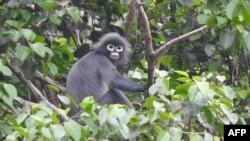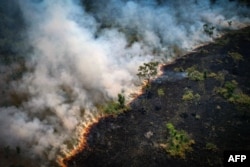The world's animal populations have decreased by more than two-thirds since 1970, recent research has said.
The report comes from the World Wildlife Fund (WWF), an environmental group based in Switzerland. The WWF used 2018 information from the Zoological Society of London (ZSL).
The London group provided information on 32,000 wildlife populations which included more than 5,000 species. The researchers found that population sizes had declined by 69 percent on average. They said loss of forests, human exploitation of the environment, pollution, and climate change were the biggest causes of the loss.
Land-use change is still the biggest threat to nature, the report said. It added, “However, if we are unable to limit warming to 1.5°C, climate change is likely to become the dominant cause of biodiversity loss” in the coming years.
Andrew Terry is the director of conservation and policy at ZSL. This "serious drop…tells us that nature is unraveling and the natural world is emptying," he said.
Wildlife populations in Latin American and the Caribbean Sea area were greatly affected. The scientists said there was a 94 percent drop in those areas in over 50 years.
'Wildlife populations in river and lake habitats decreased the most. Freshwater populations have decreased by an average of 83 percent since 1970. For example, one population of pink river dolphins in the Amazon River area of Brazil fell by 65 percent between 1994 and 2016, the report said.
The findings were similar to those in WWF's last report in 2020. Terry said wildlife population sizes continue to decrease at a rate of about 2.5 percent per year.
"Nature was in dire straits and it is still in dire straits," said Mark Wright. He is the director of science at WWF-Britain. "The war is definitely being lost."
The report calls on leaders and governments to act to deal with the crisis.
“A nature-positive future needs…shifts in how we produce, how we consume, how we govern, and what we finance,” it said.
In December, delegates from around the world will gather in Montreal, Canada. Their aim will be to create a new plan to protect the world's plants and animals.
"We are calling on the rich nations to provide financial support to us to protect our nature," said Alice Ruhweza, WWF's director for Africa.
I’m Dan Novak.
Dan Novak adapted this story based on reporting by Reuters and the WWF report.
________________________________________________________________
Words in This Story
exploit — v. to use or get value from something
dominant –adj. the most important or most influential
biodiversity –n. the existence of many different kinds of plants and animals in an environment
unravel — v. to begin to fail
habitat — n. a place, or kind of place, where plants and animals live naturally
dire strait — idiom in a very bad situation
consume — v. to use up












Forum